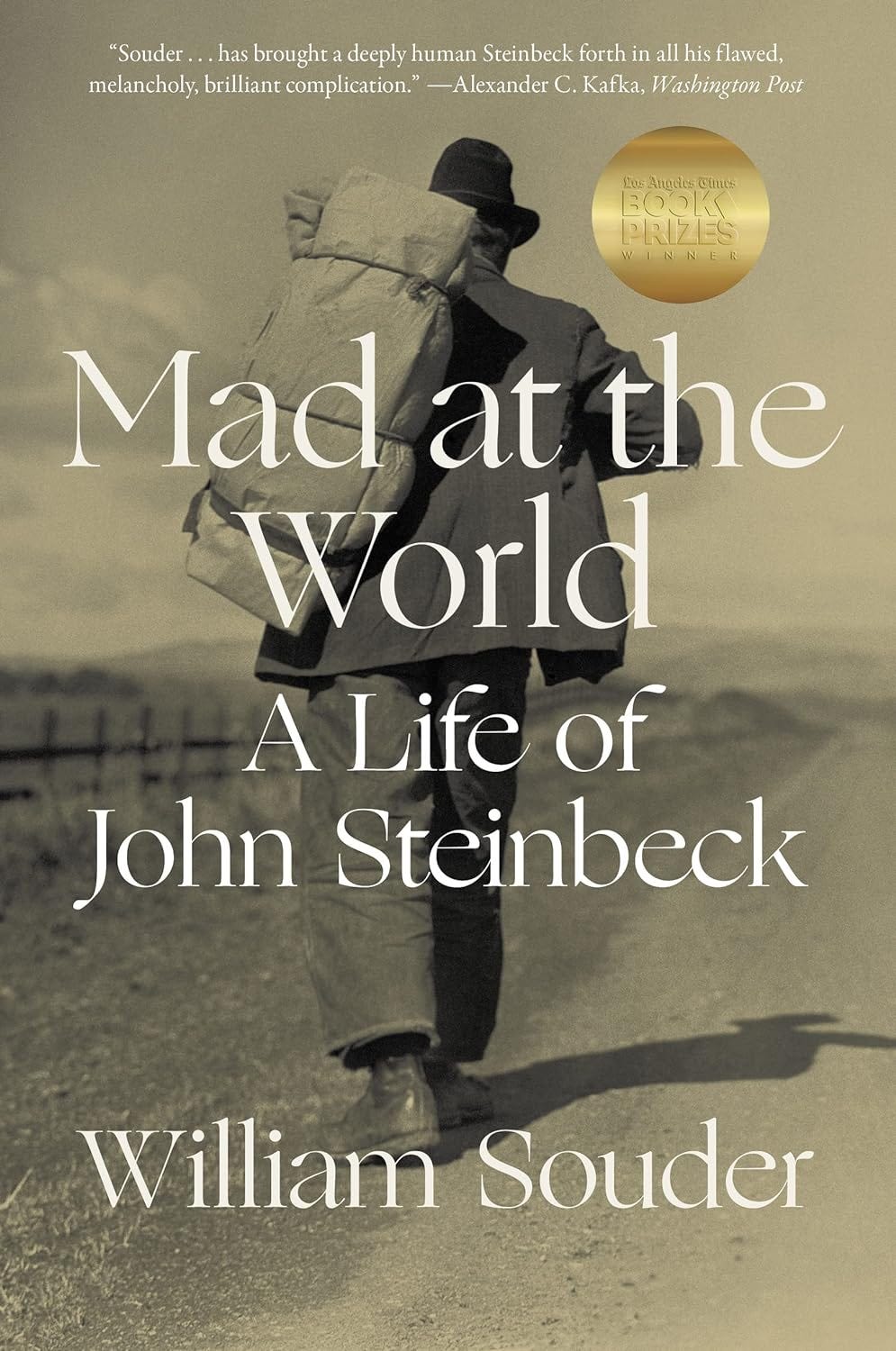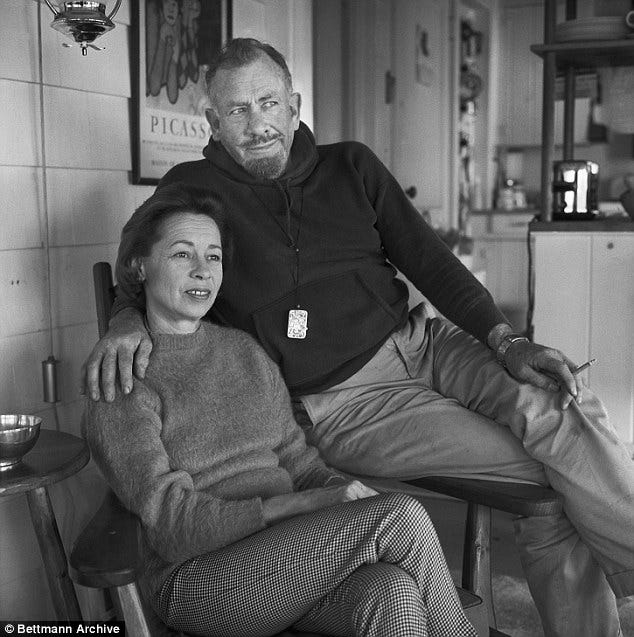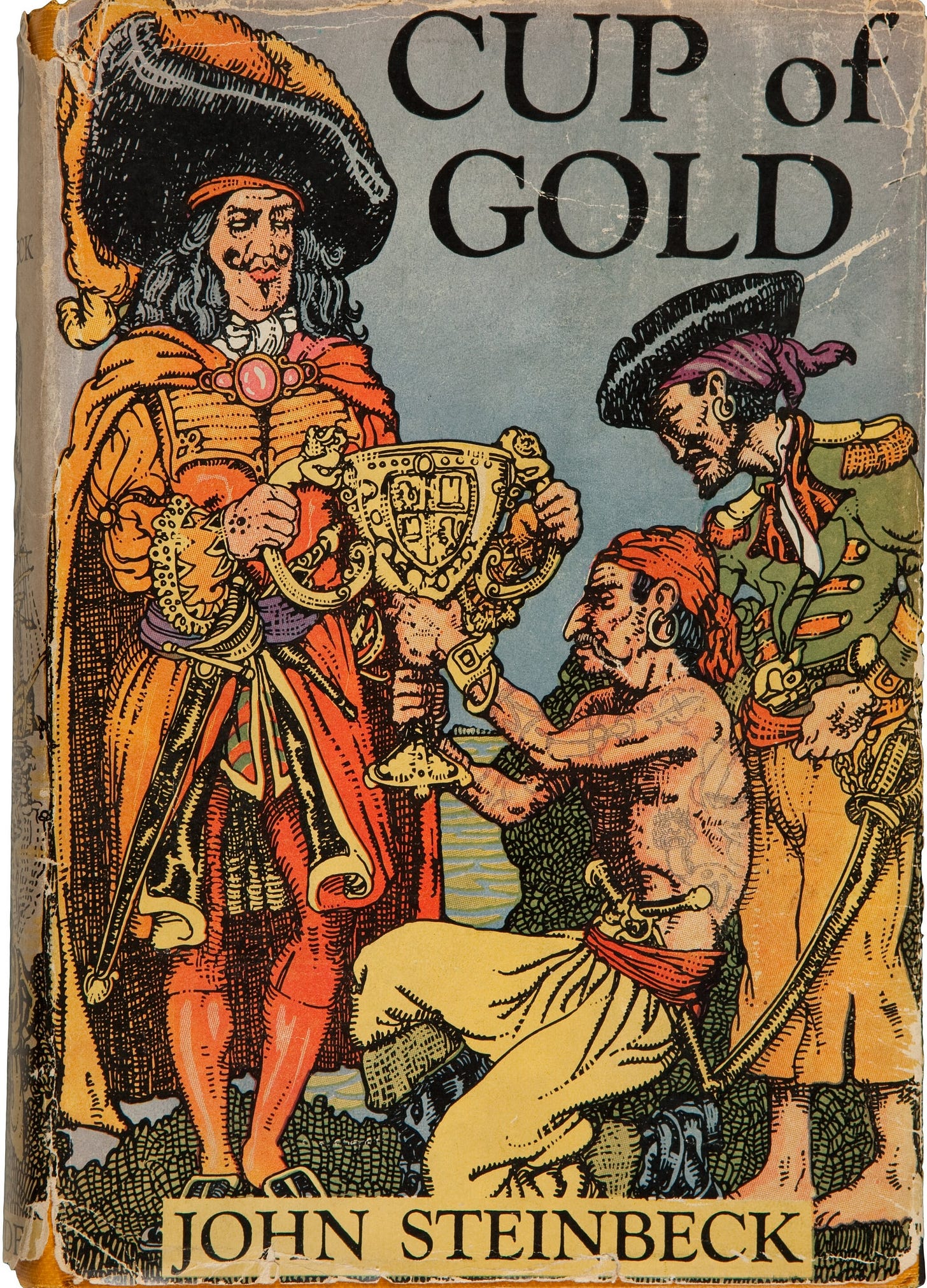The Steinbeck Review #1 - A Valley of Dreams
Mad at the World: A Life of John Steinbeck | Cup of Gold
“The writer must believe that what he is doing is the most important thing in the world. And he must hold onto this illusion, even though he knows it's not true.” ― John Steinbeck
John Steinbeck was born in 1902 in the city of Salinas, California. The valley of the same name was the focal point of his reality. No matter where he lived, the valley called to him - demanded of him the work of his pen. He explored themes of physical, mental, and spiritual journeys and the vast agricultural mecca of Salinas Valley was a common destination. Steinbeck was compelled to return time and again throughout his life, in his writing, and eventually in death.
A literary genius yet deeply complicated individual, his legacy is rarely disputed. This chronological read-through of the Nobel Laureate’s works will explore each in the order they were originally published, starting with Cup of Gold in 1929 and ending with the posthumously published Steinbeck in Vietnam: Dispatches from the War in 2012. Let us begin our journey with an examination of the man.
“No other author could get so mad at the world with such grace.” - Pat Covici
The original inhabitants of the Salinas Valley, the Ohlone Indians, lived in small villages and practiced a hunter-gatherer lifestyle. In the mid-1700s, Spanish colonizers found their way to Northern California and continued their expansion into native territories. Spanish and Mexicans sought the fertile soil of the valley to establish giant farms and ranchos. The California Land Act of 1851 broke up the massive land holdings allowing smaller farmers and ranchers to move in and stake their claim.
John Ernst Steinbeck was born into a comfortable, middle-class home, the only son of John Sr. and Olive. As a child he was spoiled by his older sisters Esther and Beth, but was closest with his younger sister Mary. Often preoccupied with his thoughts, other children liked him but considered him a loner who was friendly but serious. In school he was usually shy and indifferent.
Steinbeck loved dogs and the family always seemed to have one or two around the home. He enjoyed being outdoors and developed a love for growing things, a pastime he most likely learned from his father. He was fascinated by the mountains that surrounded the valley and regularly ventured out to explore, often with Mary in tow. They loved riding a pony named Jill, a gift for his fourth birthday, which became the inspiration for his book, The Red Pony.
A natural storyteller who loved reading, he would later recall books as “something that happened to me.” He did not care much for academics other than English which he loved. His favorite author was Sir Thomas Malory who wrote Le Morte d’Arthur. His fascination with King Arthur would influence his writing throughout his life.
“Good writing depends on the writer having something to say.” - Edith Mirrielees
Steinbeck chose Stanford for college although he was uninterested in any class not related to writing. A central figure in his education was Edith Mirrielees, a professor of English. Steinbeck loved her short-story class so much that he took it twice, hoping she would reveal the secret formula to writing.
While the impact of Miss Mirrielees, as he called her, was significant, Steinbeck couldn’t be convinced to stay in school. He would disappear for days and weeks at a time. Dropping out, he moved to New York City where he worked odd jobs, including a short stint as a reporter, hoping to get his foot in the door of the literary world. It didn’t work out.
Returning to California, he became caretaker of a remote lake property. The solitude was exactly what he needed to finally commit himself to writing. Lacking confidence as a writer, a trait that would remain even after he had found fame, he persisted and completed his first manuscript, Cup of Gold.
Steinbeck felt drained after finishing this work and wondered if he would ever find the “Sharp agony of words…” compelling him to write again. Like many writers, he believed that the act of writing did not make one a writer. Instead, true writers did so because they could not help themselves, it was something ingrained within. He was frustrated with his inability to find a publisher and became sullen and self-absorbed. For a short time he considered moving to Europe where many of the best writers of the day were living and working.
Finally, Cup of Gold was published in August 1929, a few months prior to the crash of the stock market. Steinbeck had been dating a woman named Carol and in January 1930 they were married. After a short stint in Los Angeles, they made their home at the Steinbeck vacation house in Pacific Grove near Monterey.
A life-long friendship began in 1930 when Steinbeck met Ed Ricketts. Ricketts owned a research laboratory on the waterfront in Monterey in an area known as Cannery Row. This lab would become the gathering place for the young, artistic crowd. A bohemian group of friends, they would hold wild parties which included an eclectic mix of drinking, cheap eats, strip poker, and deep conversations.
Throughout the early ‘30s, Steinbeck continued working on several projects. When his mother became ill he remained at her bedside for months, taking care of her. He used this time of relative solitude to think and write. Following her death in 1934, Steinbeck’s career took off when several works were accepted for publication in rapid succession.
He was not a fan of critics and complained about them regardless of whether they liked his work or not. At times he referred to them as “lice and bewildered bastards.” Almost pathological in his desire for privacy, he eschewed fame or notoriety.
His father died in 1935 leaving him some money. Combined with the success of his recent books, he was able to focus on writing. As he grew in fame and fortune however, he constantly struggled to manage his finances. The more money he made, the more he spent.
The market crash of 1929 had brought thousands of people west. Steinbeck had a front row seat to the mass of migrant workers following the harvest in California’s agricultural valley. Referred to as “Okies” regardless of their state of origin, these desperate individuals would find a place in Steinbeck’s heart. Throughout his entire life he had struggled seeing anyone suffer. The plight of those seeking employment, food, and hope would go on to inspire some of his greatest works.
Themes of loneliness and isolation were explored in the first of these entitled Of Mice & Men, published in 1937. Following the travels of George and Lennie, it became a bestseller at publication and solidified Steinbeck’s reputation as a writer. This was followed two years later by The Grapes of Wrath which was also a raging success. Carol played a huge part in the writing of this masterpiece.
Steinbeck’s growth as a writer was evident. Cup of Gold sold only 900 copies at publication. The Grapes of Wrath first run was over 500,000 copies. Unfortunately, while his career was taking off, his personal life was falling apart. He and Carol separated – there had been infidelity on both sides. He moved to New York City with his girlfriend Gwyn whom he would later marry after the divorce with Carol was finalized. He and Gwyn had two sons, Thomas and John. This marriage lasted barely five years. The divorce led to severe depression and Steinbeck was often heavily medicated. In 1950 he married Elayne whom he would remain with until his death.
The second half of Steinbeck’s career was filled with many successes. East of Eden, often considered his magnum opus, was published in 1952. A decade later he was awarded the Nobel Prize in Literature. Early in his career he had begun the development of a theme he called the Phalanx – the idea that a group operates as if it were a single biological unit. Critic Edmund Wilson, in writing about Steinbeck’s body of work, remarked that “biological realism was Steinbeck’s ‘natural habit of mind’ and it translated in his books to an ‘irreducible faith in life’ which Wilson admired.” Ecology, biology, and the interconnectedness of the human condition with these forces all provided a framework for Steinbeck that influenced his works.
Literary scholar James Gray, in a review of Steinbeck’s writing, wrote that what set him apart from all other writers was his anger. “All his work steams with indignation at injustice, with contempt for false piety, with scorn for the cunning and self-righteousness of an economic system that encourages exploitation, greed, and brutality.” Steinbeck’s inability to tolerate suffering in others was a theme that continued from childhood onward.
Perhaps the best testimony of his philosophy comes in his own voice as narrator, given to us in a within his masterpiece, East of Eden, speaking to the importance of freedom of thought.
“And I believe this: that the free, exploring mind of the individual human is the most valuable thing in the world. And this I would fight for: the freedom of the mind to take any direction it wishes, undirected. An this I must fight against: any idea, religion, or government which limits or destroys the individual. This is what I am and what I am about. I can understand why a system built on a pattern must try to destroy the free mind, for that is one thing which can by inspection destroy such a system. Surely I can understand this, and I hate it and I will fight against it to preserve the one thing that separates us from the uncreative beasts. If the glory can be killed, we are lost.”
Steinbeck died in December 1968 in New York City from congestive heart failure. He was cremated and his ashes were interred in his mother’s family plot in Salinas, California, returning him full circle to the place of his birth.
Mad at the World by William Souder is shorter than some other biographies of Steinbeck and is also the most recently published. It provided a good introduction, laying the foundation for deeper exploration of his life and works. Recommended for those interested in learning more about Steinbeck without getting too detailed.
“The sea rose up and snarled at them, while the ship ran before the crying dogs of the wind like a strong, confident stag…” - Cup of Gold
**Warning - Spoilers Ahead**
Since childhood, Steinbeck had adventure stories filling his imagination. The Tales of King Arthur had left a lasting impression and he longed for the opportunity to share the exploits rolling around in his head. Isolated in a remote cabin, he put pen to paper, writing his first manuscript, an adventure tale loosely based on the life and times of one Henry Morgan, pirate and buccaneer.
Henry Morgan’s short time in Wales was mundane. His dreams were those of a young man, filled with excitement. Sitting around the evening fire, his head was filled with tales of pirate adventure, told by a friend of his father’s, recently returned from a life under sail. His imagination stoked, he determines to take to ship, escaping the doldrums of Welsh farm life. His father, who had made nothing of his own life, was envious of his son but supportive of his dream. His only admonition was to seek out Merlin for advice before departing.
Morgan signs on as a scullery assistant aboard a ship sailing for the West Indies. Desiring to learn all he can of the sailing life, he spends his spare time befriending the boatswains, line handlers, sail rats, and anyone who can teach him a skill or two. A quick learner, he becomes a valuable asset to the ship, despite his young age.
Arriving in the West Indies, the first of many unexpected twists enters the life of our young adventurer. The captain of the ship sells Henry into indentured servitude to pay for his passage across the sea. Fortunately, the plantation owner who purchases his papers is not looking for another field hand. An older man without heirs, the farmer wants a companion to share his home and his love of books. Henry spends years learning everything he can from the farmer. Reading, studying, and working, he eventually takes over management of the plantation.
Never forgetting his dream of being a pirate, Henry bides his time until his master burns his papers, setting him free from service. Throughout the years on the plantation, Henry skimmed profits which he then used to acquire a ship and crew. The years passed quickly and his fame and fortune grew. Highly successful in his exploits, pirates from all over followed him for a share of the glory and loot.
Despite his reputation and good fortune, Morgan sat alone at the top of his world. He lacked friendship and fulfillment because “the time he had dwelt alone in the castle of himself had been so long.” He believe the only way to find the answer to his dreams was to obtain the ultimate prize, La Santa Roja, a woman of indescribable beauty. In order to claim her he must first conquer the fortified city of Panama. Morgan finds success in conquering the city but is unable to claim the heart of the woman. The dream he had chased his entire life betrayed and eluded him in the end.
Correlations exist between this story and Steinbeck’s life. His own father had made almost nothing of himself but was supportive of his son’s dreams the same that Henry Morgan’s father was. In what seems prescient looking back, Steinbeck would also continually search for love and companionship that eluded him. His life was filled with success, fortune, friends, and women but he struggled to make any of it last.
Merlin’s appearance in this 17th century tale, some 400 years after King Arthur, is a testament to the Arthurian legend’s impact on Steinbeck and representative of the lasting power of magic and dreams. It is a roguish adventure tale, enjoyable in a childlike, dreamy way.
Steinbeck’s first published work met with mixed reviews and has remained one of his least popular works. There are inspired moments, indicating the genius of what was to come, but it seems that Steinbeck needed to get this one out of his system in order to make space for future greatness. This book is best left for true fans of pirate tales and those trying to read all Steinbeck’s works.
I would love to hear from you in the comments. Have you read anything by Steinbeck? What was your impression? Any favorites?
Until next month…
Interested in supporting independent bookstores…
Check out my shop on Bookshop.org. The majority of profits support independent booksellers and as an affiliate I receive a small commission.
This newsletter is entirely reader supported. All content is provided free of charge. If you enjoy my writing, please consider subscribing at one of the paid tiers. For less than the cost of one cup of coffee per month, I am able to continue supporting literacy initiatives. Thank you.
Share the experience!
Do you enjoy the content provided by The Books of Our Lives? Consider sharing it with others who may find value in it as well.









This is excellent! Thanks for sharing it with us.
I thought your essay was excellent. I am tempted to read along, but I think I am maxed out with Simon’s two books.
I was in high school in the early ‘70s, and I think the first Steinbeck I read was In Dubious Battle. Later, we read The Grapes of Wrath, and I remember getting a lot of praise for my essay about it.
After high school, I casually dated a guy who was going to college in Colorado who had been in my high school graduating class. His roommate at college was from Watsonville, which is the Salinas Valley.
On one of their breaks from school, my friend and I drove down and had lunch at the home of the roommate's parents. Later, we drove by the Steinbeck house.
What impressed me about the two houses was that they reminded me of houses — Victorians. — that one sees in San Francisco, except they are sitting on lots surrounded by fields of artichokes and broccoli.
Great essay!